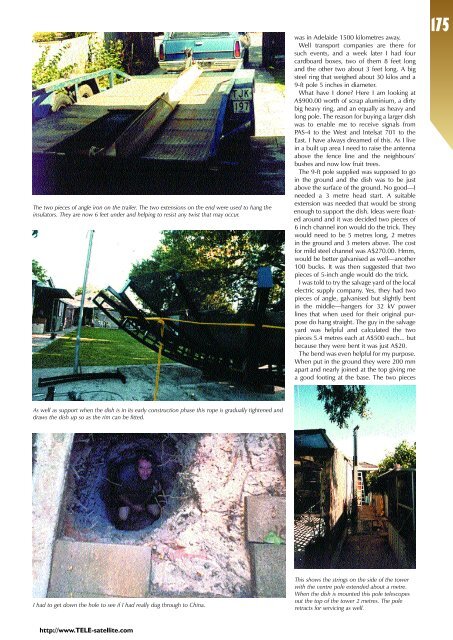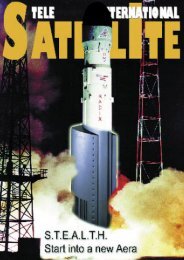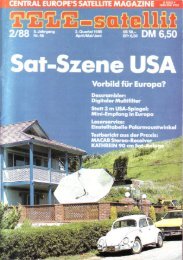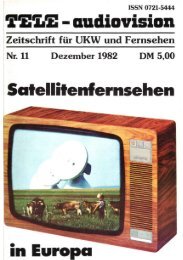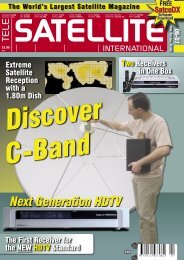Bestellen Sie diesen Satelliten- Newsletter! - TELE-satellite ...
Bestellen Sie diesen Satelliten- Newsletter! - TELE-satellite ...
Bestellen Sie diesen Satelliten- Newsletter! - TELE-satellite ...
Create successful ePaper yourself
Turn your PDF publications into a flip-book with our unique Google optimized e-Paper software.
The two pieces of angle iron on the trailer. The two extensions on the end were used to hang the<br />
insulators. They are now 6 feet under and helping to resist any twist that may occur.<br />
As well as support when the dish is in its early construction phase this rope is gradually tightened and<br />
draws the dish up so as the rim can be fitted.<br />
I had to get down the hole to see if I had really dug through to China.<br />
http://www.<strong>TELE</strong>-<strong>satellite</strong>.com<br />
was in Adelaide 1500 kilometres away.<br />
Well transport companies are there for<br />
such events, and a week later I had four<br />
cardboard boxes, two of them 8 feet long<br />
and the other two about 3 feet long. A big<br />
steel ring that weighed about 30 kilos and a<br />
9-ft pole 5 inches in diameter.<br />
What have I done? Here I am looking at<br />
A$900.00 worth of scrap aluminium, a dirty<br />
big heavy ring, and an equally as heavy and<br />
long pole. The reason for buying a larger dish<br />
was to enable me to receive signals from<br />
PAS-4 to the West and Intelsat 701 to the<br />
East. I have always dreamed of this. As I live<br />
in a built up area I need to raise the antenna<br />
above the fence line and the neighbours’<br />
bushes and now low fruit trees.<br />
The 9-ft pole supplied was supposed to go<br />
in the ground and the dish was to be just<br />
above the surface of the ground. No good—I<br />
needed a 3 metre head start. A suitable<br />
extension was needed that would be strong<br />
enough to support the dish. Ideas were floated<br />
around and it was decided two pieces of<br />
6 inch channel iron would do the trick. They<br />
would need to be 5 metres long, 2 metres<br />
in the ground and 3 meters above. The cost<br />
for mild steel channel was A$270.00. Hmm,<br />
would be better galvanised as well—another<br />
100 bucks. It was then suggested that two<br />
pieces of 5-inch angle would do the trick.<br />
I was told to try the salvage yard of the local<br />
electric supply company. Yes, they had two<br />
pieces of angle, galvanised but slightly bent<br />
in the middle—hangers for 32 kV power<br />
lines that when used for their original purpose<br />
do hang straight. The guy in the salvage<br />
yard was helpful and calculated the two<br />
pieces 5.4 metres each at A$500 each... but<br />
because they were bent it was just A$20.<br />
The bend was even helpful for my purpose.<br />
When put in the ground they were 200 mm<br />
apart and nearly joined at the top giving me<br />
a good footing at the base. The two pieces<br />
This shows the strings on the side of the tower<br />
with the centre pole extended about a metre.<br />
When the dish is mounted this pole telescopes<br />
out the top of the tower 2 metres. The pole<br />
retracts for servicing as well.<br />
175


